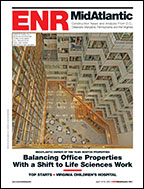Prices for diesel fuel, structural steel, lumber and gypsum-wallboard products started to stir during the first quarter, but most increases were coming off dismal lows in 2009 and were not strong enough to break the stranglehold the recession has on construction costs. Eleven of 15 major industry cost indexes tracked by ENR showed costs falling below a year ago. These drops included year-to-year declines of 5.8% for warehouse construction, 4.7% for office buildings and 1.7% for school construction, according to the U.S. Commerce Dept.’s January cost indexes. The agency also reported in January another 3.6% decline in homebuilding costs during the same time in 2009. This decrease marked the third consecutive year the Commerce Dept. cost index for new homebuilding has declined, following drops of 3.2% in 2009 and 2.6% in 2008.
The deepest cost declines were measured by selling price indexes, which reflect the stiff competition between subcontractors and their dwindling margins. Among commercial price indexes, one issued by Turner Construction Co. fell 0.5% this quarter and 7.7% for the year. The Rider Levett Bucknall selling price index also fell 0.5% for the quarter and is down 7.3% for the year.
Most of the deflation in construction cost indexes can be tied to subcontractors slashing bids, despite some growing pressure from rising commodity prices. As the homebuilding market shows some signs of bottoming out, lumber, plywood and gypsum-wallboard prices are starting to bounce back after years of depressed levels. The average mill price for softwood framing lumber—tracked by the Eugene, Ore.-based pricing specialist Random Lengths—was $312 per thousand board-ft in February. That price was up 56% from last year’s low but is still 26% below the peak of February 2005.
Likewise, the Random Lengths composite index for panel prices in February rebounded 20% from last year’s low point but is 44% below its previous peak.
The rebound in gypsum-wallboard prices lags behind that of lumber, but price increases are starting to pop there as well. The U.S. Bureau of Labor Statistics’ (BLS) February producer price index for gypsum wallboard rose 1.1%, the biggest monthly increase since August 2008, says Armine Thompson, building-materials analyst for forecasting firm IHS Global Insight, Washington, D.C. But he believes it will take most of 2010 for the wallboard market to shake off the effects of the recession. Wallboard prices are likely to end this year with an overall 6.7% decline before turning up 4.6% in 2011, followed by another 4.5% gain in 2012, according to Thompson.
Another rebounder that is not having the impact on overall costs it once did is diesel fuel. The BLS producer price index for diesel fuel jumped 11.5% in January, which lifted it 41.4% above 2009’s level. This increase is coming off low levels. Six months ago, the diesel fuel index was running 60% below 2008’s level.
Nevertheless, Thompson says that asphalt paving prices cannot ignore higher oil prices for long. She predicts prices will end the year 5.1% higher, after dropping 12% in 2009.
Other price increases for commodities such as copper and aluminum may be temporary blips. “Copper and aluminum prices have moved way ahead of market fundamentals,” says John Mothersole, a IHS Global Insight principal. “We don’t think the end markets, especially in the U.S., are strong enough to accept these kind of price increases, and weak demand will start pushing back during the next two quarters,” he says. “Our top-line inflation forecast remains very muted.”
The recession in the non-residential building market in 2009 has made short work of steel-price spikes in 2008. Structural-steel prices now are hovering around their 2004 to 2006 levels, according to John Anton, IHS Global...



Post a comment to this article
Report Abusive Comment